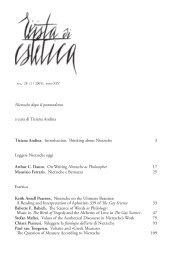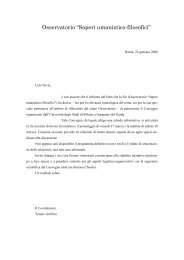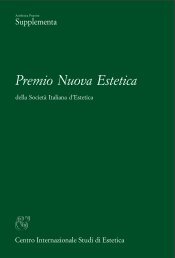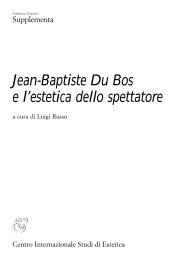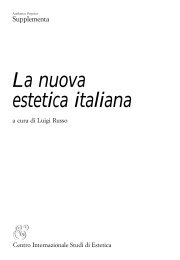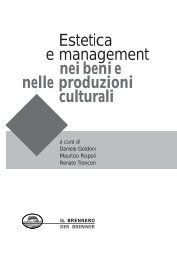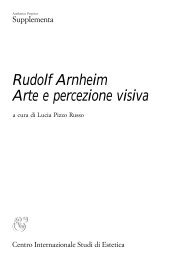scinanti, perché rappresentano più schiettamente la natura, e sono avvolte da una magnificenzache supera di gran lunga le ridicole contraffazioni dei giardini principeschi».8La regola <strong>del</strong> gusto (1758), in Saggi di estetica, tr. it. a c. di I. Zaffagnini, Parma 1994,pp. 39-62: «La bellezza non è una qualità <strong>del</strong>le cose stesse: essa esiste soltanto nella menteche la contempla e ogni mente percepisce una diversa bellezza» (p. 42).9Ivi, p. 43 ss. Sul gusto in Hume vd. E. Franzini e A. G., “La gran varietà dei gusti”. Aproposito dei Saggi di estetica di David Hume, in “Quaderni Utinensi”, VIII [15-16] (1990, ma1996), pp. 383-91; inoltre E. Franzini [e M. Mazzocut-Mis], Estetica. I nomi, i concetti, lecorrenti, Milano 1996, pp. 208-219 (6. “Gusto”): p. 214 ss.10Saggio sulla libertà (1859), tr. it di S. Magistretti, Milano 1993 2 , p. 117.11Vd. in proposito un celebre luogo dalla IV sez. <strong>del</strong>la Ricerca sull’intelletto umano(1748), tr. it. di E. Mistretta, in Opere filosofiche, a c. di E. Lecaldano, Bari 1987, III, p. 43:«… tutte le inferenze dall’esperienza suppongono, come loro fondamento, che il futuro assomiglieràal passato […]. Se vi fosse qualche sospetto che il corso <strong>del</strong>la natura potesse cambiare,e che il passato potesse non servire di regola per il futuro, l’intera esperienza diventerebbeinutile e non potrebbe dare origine a inferenze o conclusioni. È dunque impossibileche argomenti ricavati dall’esperienza possano provare questa somiglianza <strong>del</strong> passato colfuturo, poiché tutti questi argomenti sono fondati appunto sulla supposizione di tale somiglianza».12Della persistenza di motivi platonici e neoplatonici nella cultura inglese, non solo settecentesca,ho trattato in Plato Britannicus. Sulla tradizione platonica nella storia <strong>del</strong> pensieroinglese (2000), in “Et in Britannia Plato”, cit., pp. 157-99,13In proposito vd. la celebre “gerarchia <strong>del</strong>le forme” in Moralisti III 2, ed. cit., pp. 190-93.14I piaceri <strong>del</strong>l’Immaginazione, ed. cit., p. 35 ss.: «Una <strong>del</strong>le cause finali <strong>del</strong> diletto chesi prova dinnanzi a tutto ciò che è grande può essere la seguente. L’Autore supremo <strong>del</strong> nostroessere ha foggiato l’anima <strong>del</strong>l’uomo in modo tale che nulla, se non Lui stesso, può essere<strong>del</strong>l’anima l’ultima, adeguata e appropriata felicità. Poiché allora gran parte <strong>del</strong>la nostrafelicità deve scaturire dalla contemplazione <strong>del</strong> Suo essere, al fine di far pregustare adeguatamentealla nostra anima una tale contemplazione, Egli ha fatto sì che essa si diletti spontanemantenel percepire ciò che è grande o illimitato».15Vd. il Trattato sulla natura umana (1939-40), II 2, 5, tr. it. di A. Carlini e al., in Operecomplete, cit., I, p. 380 ss.16In Second Characters, or the Language of Forms, ed. by B. Rand, London 1914 [NewYork 1969], pp. 29-61. Su Shaftesbury e De Matteis: W. Wells, Shaftesbury and Paolo deMatteis. The Choice of Hercules, “Leeds Arts Calendar”, 12 (1950), 3, pp. 23-28; L. Pestilli,Lord Shaftesbury e Paolo de Matteis: Ercole al bivio tra teoria e pratica, “Storia <strong>del</strong>l’arte”, 68(1990), pp. 95-121; M. Ferrando, Shaftesbury: il Giudizio di Ercole e il giudizio estetico,“Rivista di estetica”, n.s., 7 (1998), XXXVIII, pp. 111-20.17L’estetica <strong>del</strong>l’empirismo inglese, Firenze 1944, I, pp. 58-65 e 309-431 (Shaftesbury).18Cfr. il primo capitolo <strong>del</strong>la Notion, ove a proposito <strong>del</strong> dipinto storico egli scrive: «…in the representation of any event, or remarkable fact, the probability or seeming truth (whichis the real truth of art) may with the highest advantage be supported and advanced» (inSecond Characters, cit., p. 33).19Vd. quanto ho scritto al riguardo in La “rivolta anticlassica” nell’estetica inglese tardosettecentesca:William Blake, John Constable e William Wordsworth (1996), in “Et in BritanniaPlato”, cit., pp. 131-56.20Ed. a c. di chi scrive: Per una bibliografia <strong>del</strong>l’età augustea. Il Catalogue <strong>del</strong>la bibliotecadi Joseph Addison, “Rendic. <strong>del</strong>l’Accad. Naz. dei Lincei”, c.s.21Plastics, or the Original Progress and Power of Designatory Art (1712), in Second Characters,cit., pp. 152 (Bernini), 128 (Carracci), 133 (Caravaggio) e 171 (Reni).22«Arts (as well as husbandry and manufactures, both in this country and in France)decline lamentably. At Rome, Florence, &c., no encouragement, nor youth coming up, thePope himself quitting his virtuoso-genius since he is grown into the cares of a politician»(Lett. a Th. Micklethwayte <strong>del</strong> 19 genn. 1712, in The Life, Unpublished Letters and PhilosophicalRegimen of Anthony, Earl of Shaftesbury, ed. by B. Rand, London & New York1900, p. 464). E ancora: «… never was such a deadness as to all arts in Italy» (Lett. a JohnCropley <strong>del</strong> 16 febb. 1712, ivi, p. 468).23Così Shaftesbury nella lettera al rev. John Fagan <strong>del</strong> 23 genn. 1712, a proposito <strong>del</strong>-34
la decadenza <strong>del</strong>le arti e <strong>del</strong>le scienze in Italia: «… how much these are declining in this place,you may judge by this very instance, that now, since the late wars and revolutions, someof the chief university schools and conveniences of the students are turned into stables andquarters for the soldiers. The academies for painting are in a proportionable state. And Ihave little hopes of finding a young painter to employ […] in copying the great masters anddrawing things of history, statuary, and the Roman and other antiquities…» (ivi, p. 467).24N. Penny, An Ambitious Man: The career and the achievements of Sir Joshua Reynolds,in Reynolds (Cat. of the Exhibit., 16 Jan.-31 Mar.), ed. by N.P., London 1986, pp. 17-42:p. 20: «It was suggested to Reynolds […] that he should study with Batoni, but Reynolds repliedthat he had nothing to learn from him»; e aggiunge Penny: «It is evident that Reynoldsfelt that modern Italian painters had no real connection with the Old Masters». L’episodioera stato già riportato, con qualche variante, da D. Hudson, Sir Joshua Reynolds. A personalstudy, London 1958, p. 34.25Vd. il quinto (1772) dei suoi Discorsi sull’arte (1769-90), tr. it. di P. Prestini, Introd.di A.G., Segrate (MI) 1997, pp. 59-74: p. 68.26A. Ottani Cavina, Fuga dalle tenebre. I nordici a Roma nel cerchio di Füssli, in Füsslipittore di Shakespeare. Pittura e teatro 1775-1825 (cat. <strong>del</strong>la mostra, Traversetolo, PR, 7 sett.-7 dic. 1997), a c. di F. Licht & al., Milano 1997, pp. 15-21: pp. 20 e 16 le citaz. L’autricesembra ripetere qui il giudizio di G. Briganti, I pittori <strong>del</strong>l’immaginario. Arte e rivoluzionepsicologica, Milano 1989 2 , p. 136, secondo cui per gli artisti “nordici”, la gran parte dei qualiinglesi, «quegli anni passati a Roma, nel decennio fra il 1770 e il 1780 in un isolamento quasitotale dall’ambiente artistico circostante, […] furono fondamentali non solo per la loro singolaformazione ma anche per il determinarsi di uno stile comune e di una nuova sensibilitàche non aveva, allora, equivalenti in Europa».27History of Criticism and Literary Taste in Europe from the Earliest Texts to the PresentDay, II. From the Renaissance to the Decline of Eighteenth Century Orthodoxy, Edinburgh &London, 1961 8 , p. 158.28Shaftesbury in Italia, “La critica”, XXIII, s. II, XVI (1925), pp. 1-34: pp. 18 e 27 le citaz.= Uomini e cose <strong>del</strong>la vecchia Italia, Bari 1927, I, pp. 272-309 (senza Lettere inedite inApp.): pp. 296 e 308.35
- Page 1 and 2: Aesthetica PreprintGuido Morpurgo-T
- Page 4 and 5: Guido Morpurgo-Tagliabuee l’estet
- Page 6 and 7: Un marziano in esteticadi Luigi Rus
- Page 8 and 9: sava candidamente - nel pianificare
- Page 10 and 11: che onora la cultura italiana, si p
- Page 12 and 13: grafia estetica era stato dominato
- Page 14 and 15: sciuto di Morpurgo e che ha avuto f
- Page 16 and 17: Morpurgo-Tagliabuee l’estetica in
- Page 18 and 19: e l’estetica idealista italiana m
- Page 20 and 21: queste due «novità fondamentali»
- Page 22 and 23: 4Pubblicati rispettivamente in “R
- Page 24 and 25: un’estetica piuttosto articolata
- Page 26 and 27: Non desidero limitarmi a rilevare l
- Page 28 and 29: imprecisione: le differenze indicat
- Page 30 and 31: ino»; e la seconda accusa, conclud
- Page 34 and 35: Morpurgo-Tagliabuee l’estetica de
- Page 36 and 37: pensava soprattutto al fatto che il
- Page 38 and 39: apprende l’armonia della musica.
- Page 40 and 41: dal punto di vista del fruire: […
- Page 42 and 43: Bodmer riportava larghi estratti de
- Page 44 and 45: Morpurgo-Tagliabuee l’estetica it
- Page 46 and 47: de quella stagione determinata, dal
- Page 48 and 49: che «in pratica dal giudicio dell
- Page 50 and 51: che agguaglino la forza degli origi
- Page 52 and 53: Perfetta poesia, e cioè quando Mur
- Page 54 and 55: 28Ibid., p. 63.29G. B. Gravina, De
- Page 56 and 57: è l’incrocio Gravina-Vico operat
- Page 58 and 59: classe nell’individuo, il quale,
- Page 60 and 61: Siano qui sufficienti alcuni cenni:
- Page 62 and 63: Implicazioni del nessotra gusto e g
- Page 64 and 65: gusto abbia statuto catacretico e i
- Page 66 and 67: espresso dall’effetto. Da un lato
- Page 68 and 69: modello del significare segnico in
- Page 70 and 71: ne» 3 . Scrive Morpurgo-Tagliabue
- Page 72 and 73: mento che quest’ultima implica un
- Page 74 and 75: do Morpurgo-Tagliabue gusto e giudi
- Page 76 and 77: conseguenza possiamo identificare u
- Page 78 and 79: 1Guido Morpurgo-Tagliabue, Il conce
- Page 81 and 82: Guido Morpurgo-Tagliabue:le sublime
- Page 83 and 84:
son assimilation ultime à l’él
- Page 85 and 86:
pective, comparer à celle de Giamb
- Page 87 and 88:
(3) Cet idéal de beauté féminine
- Page 89 and 90:
hors de l’écheveau complexe du v
- Page 91 and 92:
Prendre le parti d’un tableau pr
- Page 93 and 94:
tion» sur laquelle insiste Wittgen
- Page 95 and 96:
Mais le problème est de ne pas se
- Page 97 and 98:
33 Ricercari Nowau. Una forma di or




